What would your future-you have to say to you?
The no-pants guide to spending, saving, and thriving in the real world.
What would your future-you have to say to you?
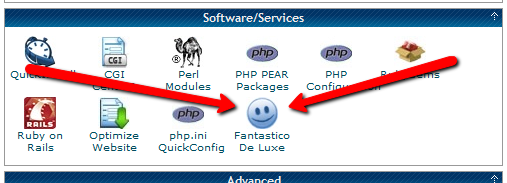
In this installment of the Make Extra Money series, I’m going to show you how to set up a WordPress site. I’m going to show you exactly what settings, plugins, and themes I use. I’m not going to get into writing posts today. That will be next time.
I use WordPress because it makes it easy to develop good-looking sites quickly. You don’t have to know html or any programming. I will be walking through the exact process using Hostgator, but most hosting plans use CPanel, so the instructions will be close. If not, just follow WordPress’s 5 minute installation guide.
Assuming you can follow along with me, log in to your hosting account and find the section of your control panel labeled “Software/Service”. Click “Fantastico De Luxe”.

On the Fantastico screen, click WordPress, then “New Installation”.

On the next screen, select your domain name, then enter all of the details: admin username, password, site name, and site description. If you’ll remember, I bought the domain http://www.masterweddingplanning.net. I chose the site name of “Master Wedding Planning” and a description of “Everything You Need to Know to Plan Your Wedding”.
Click “install”, then “finish installation”. The final screen will contain a link to the admin page, in this case, masterweddingplanning.net/wp-admin. Go there and log in.
After you log in, if there is a message at the top of the screen telling you to update, do so. Keeping your site updated is the best way to avoid getting hacked. Click “Please update now” then “Update automatically”. Don’t worry about backing up, yet. We haven’t done anything worth saving.
Next, click “Settings” on the left. Under General Settings, put the www in the WordPress and site URLs. Click save, then log back in.
Click Posts, then Categories. Under “Add New Category”, create one called “Misc” and click save.
Click Appearance. This brings you to the themes page. Click “Install Themes” and search for one you like. I normally use Headway, but before I bought that, I used SimpleX almost exclusively. Your goal is to have a simple theme that’s easy to maintain and easy to read. Bells and whistles are a distraction.
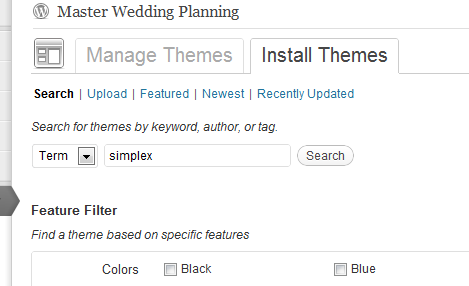
Click “Install”, “Install now”, and “Activate”. You now have a very basic WordPress site.
A plugin is an independent piece of software to make independent bits of WordPress magic happen. To install the perfect set of plugins, click Plugins on the left. Delete “Hello Dolly”, then click “Add new”.
In the search box, enter “plugin central” and click “Search plugins”. Plugin Central should be the first plugin in the list, so click “install”, then “ok”, then “activate plugin”. Congratulations, you’ve just installed your first plugin.
Now, on the left, you’ll see “Plugin Central” under Plugins. Click it. In the Easy Plugin Installation box, copy and paste the following:
All in One SEO Pack Contact Form 7 WordPress Database Backup SEO SearchTerms Tagging 2 WP Super Cache Conditional CAPTCHA for WordPress date exclusion seo WP Policies Pretty Link Lite google xml sitemaps Jetpack by WordPress.com
Click “install”.
On the left, click “Installed Plugins”. On the next screen, click the box next to “Plugins”, then select “Activate” from the dropdown and click apply.
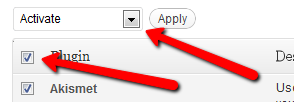
Still under Plugins, click “Akismet Configuration”. Enter your API key and hit “update options”. You probably don’t have one, so click “get your key”.
The only tool I worry about is the backup. It’s super-easy to set up. Click “Tools”, then “Backup”. 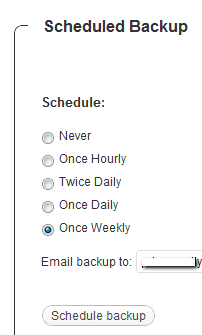
Scroll down to “Schedule Backups”, select weekly, make sure it’s set to a good email address and click “Schedule Backup”. I only save weekly because we won’t be adding daily content. Weekly is safe enough, without filling up your email inbox.
There are a lot of settings we’re going to set. This is going to make the site more usable and help the search engines find your site. We’re going to go right down the list. If you see a section that I don’t mention, it’s because the defaults are good enough.
Set the Default Post Category to “Misc”.
Visit this page and copy the entire list into “Update Service” box. This will make the site ping a few dozen services every time you publish a post. It’s a fast way to get each post indexed by Google.
Click “Save Changes”.
Uncheck everything under “Email me whenever…” and hit save. This lets people submit comments, without actually posting the comments or emailing me when they do so. Every once in a while, I go manually approve the comments, but I don’t make it a priority.
Select “Custom structure” and enter this: /%postname%/
Click save.
Set the status to “Enabled”, then fill out the site title and description. Keep the description to about 160 characters. This is what builds the blurb that shows up by the link when you site shows up in Google’s results.
Check the boxes for “Use categories for META keywords” and “Use noindex for tag archives”.
Click “Update Options”.
Check the boxes to remove each of the dates and set the alt text to “purpose” or something. This will suppress the date so your posts won’t look obsolete.
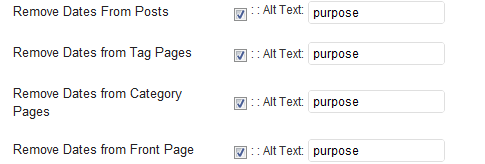
This plugin reinforces the searches that bring people to your site. It’s kind of neat. Skip the registration, accept the defaults and hit save.
Scroll to the bottom and click import. We’ll come back to this.
Select “Caching On” and hit save.
Across the top of the screen should be a giant banner telling you to connect to WordPress.com and set up Jetpack. You’ll need an account on WordPress.com, so go there and set one up. After authorizing the site, you’ll be brought back to the Jetpack configuration screen. Click “Configure” under “WordPress.com Stats”. Take the defaults and hit save.
On the contact configuration page, copy the code in the top section. You’ll need this in a moment.

Now, we going to create a couple of static pages. On the left, click “Pages”, then “Add new”.
Name the first page “Contact” and put the contact form code in the body of the page. Hit publish.
Under Appearance, click “Menu”. Enter a menu name and hit save.
Then, under “Pages”, click the box next to “Contact”, “Disclaimer”, and any other policies you’d like to display. Hit save.
Also under Appearance, click “Widgets”. This is where you’ll select what will display in the sidebar. All you have to do is drag the boxes you want from the middle of the page to the widget bar on the right. I recommend Text, Search, Recent Posts, Popular Search Terms and Tag Cloud. In the text box, just put some placeholder text in it, like “Product will go here”. We’ll address this next time.
We’re not going to worry about getting posts in place, yet. That will be the next installment. However, the steps in the next installment could take 2 weeks to implement, and we want Google to start paying attention now. To make that happen, we need to get a little bit of content in place. This won’t be permanent content. It’s only there so Google has something to see when it comes crawling.
To get this temporary, yet legal content, I use eZineArticles. Just go search for something in your niche that doesn’t look too spammy.
Then, click “Posts”, then delete the “Hello World” post. Click “Add new”. Copy the eZine article, being sure to include the author box at the bottom, and hit publish.
To see your changes, you may have to go to Settings, then WP Cache and delete the cache so your site will refresh.
Congratulations! You now have a niche blog with content. It’s not ready to make you any money, yet, but it is ready for Google to start paying attention. In the next installment, I’ll show you how I get real unique content and set it up so Google keeps coming back to show me the love.
Today, I am continuing the series, Money Problems: 30 Days to Perfect Finances. The series will consist of 30 things you can do in one setting to perfect your finances. It’s not a system to magically make your debt disappear. Instead, it is a path to understanding where you are, where you want to be, and–most importantly–how to bridge the gap.
I’m not running the series in 30 consecutive days. That’s not my schedule. Also, I think that talking about the same thing for 30 days straight will bore both of us. Instead, it will run roughly once a week. To make sure you don’t miss a post, please take a moment to subscribe, either by email or rss.
On this, Day 10, we’re going to talk about debt insurance.
Debt insurance is insurance you pay for that will pay your lender in the event of your death, dismemberment, disfigurement, disembowelment, or unemployment. Exactly what is covered varies by insurer, type of debt, and what you are willing to pay for.
Private Mortgage Insurance(PMI) is a common form of debt insurance. Generally, if you take out a mortgage with a down payment under 20%, you’ll be expected to pay for PMI. According to the Homeowners Protection Act of 1998, you have the right to request your PMI be cancelled after reducing your loan amount to 78% of the appraised value of the property. That ensures that the lender will be able to recoup their money by seizing the mortgaged property if you should happen to fall under a bus or get hit by a meteorite.
Another common form of debt insurance is for your credit cards. Card companies love it when you buy their insurance. If you buy their life insurance, your card is paid off when you die. Disability insurance pays it if your get hurt. Unemployment insurance…you get the idea.
Here’s the deal: Get life insurance and disability insurance separately. It’s cheaper than getting it through your credit card company and let’s you get enough to actually live on if something tragic happens. Unless, of course, you die. Then it will leave enough for your heirs to live on.
As far as unemployment insurance, build up your emergency fund instead. That’s money that gives you options. Credit card insurance is money flushed down the toilet. Many of these policies cost 1% of your balance. If you’ve got a $5,000 balance, that will mean you are paying $50 per month. By comparison, if you’ve got a 9.9% interest rate, you’ll be paying about $40 per month in interest.
Debt insurance is a bad idea, if you can possibly avoid it. A combination of life insurance, disability insurance, and an emergency fund provide better protection with more flexibility.
Your task for today is to review your credit card statements and mortgage agreement and see if you are paying debt insurance on any of it. If you are, cancel and set up the proper insurance policies to protect yourself and your family.

“Saving is too hard.”
“I don’t know where to start.”
“How much should I save?”
“Who the heck are you to tell me what to do with my money?”
“Shut up, Jason.”
These are the things I hear when I start talking about getting a good strategy in place to save some money. Financial matters are intimidating to a lot of people. They’d rather not think about their money any more than they absolutely need to, if that much. Here, I’m breaking it down to some simple steps to make saving easy.
1. Get motivated. Why do you want to save some money? Are you trying to make a secure future, or do you just want to buy a new toy? These are the kind of questions you have to ask yourself. Nobody else can tell you why you want to make changes to your lifestyle, and nobody else’s reasons matter in the least. Saving money is something you have to do for you.
2. Figure out how much you can save. Generally, you’re going to need a budget so you can figure out what you can afford to save, but not always. If you are making ends meet, then you get a raise, you can obviously afford to bank the difference. If you do that, you’ll never even notice the missing money. If you try to save so much your mortgage goes unpaid, you’re plan is doomed to failure.
3. Open an account at a new bank. The biggest problem I used to have when I was trying to save was that it was too easy to get the money. Every time I checked the balance of my checking account, I saw the balance in the savings account. Worse, it took seconds to transfer that money from my savings account to my attached checking account. Every time I wanted to see if I could afford whatever toy I was looking at, I’d see money that wasn’t earmarked for anything in particular. Naturally, that money got spent more often that it was ignored and allowed to grow. Now, I can completely forget about the money.
4. Automate. I’ve automated everything I can. All of my bills are paid automatically, except for one company that insists on quarterly paper invoices. I’ve got $665(neighbor of the beast!) automatically transferred to my INGDirect account, to get divided between my various savings goals, including a fund for my semi-annual property tax payments and a fund to pay for the braces we haven’t actually had to buy yet, but will in a couple of years. The money disappears into a bank I don’t use for my day-to-day expenses and grows completely out of sight. Every once in a while, I look at the account and get surprised by how much has accumulated.
5. Get rich. Once you’ve got the other four steps in place, all you’ve got to do is let it work. Over time, you will build wealth in a way that may surprise you. Your goal at this point is to do nothing new. Every once in a while, you can pull out some money and tuck it into an investment account to get some real growth going for you.
“Thank you.”
“You’re the best.”
“What would I do without you?”
“How can I show you my appreciation? <wink><wink>”
“What the heck are you doing with my wife?”
These are the things I always hope to hear after sharing my strategies to save money.
Friday was my biggest traffic day, ever. Mike‘s guest post, Brown Bagging Your Way to Savings, went slightly nuts on reddit. For a few hours, it was in the top 10 on the front page, generating more traffic every half hour than I normally see in a day. That was fun.
In other news, my kid is in the #2 slot for wrestling the heavyweight slot on his wrestling team.
This month, I am trying to establish the Slow Carb Diet as a habit. At the end of the month, I’ll see what the results were and decide if it’s worth continuing. For those who don’t know, the Slow Carb Diet involves cutting out potatoes, rice, flour, sugar, and dairy in all their forms. My meals consist of 40% proteins, 30% vegetables, and 30% legumes(beans or lentils). There is no calorie counting, just some specific rules, accompanied by a timed supplement regimen and some timed exercises to manipulate my metabolism. The supplements are NOT effedrin-based diet pills, or, in fact, uppers of any kind. There is also a weekly cheat day, to cut the impulse to cheat and to avoid letting my body go into famine mode.
I’m measuring two metrics, my weight and the total inches of my waist , hips, biceps, and thighs. Between the two, I should have an accurate assessment of my progress.
Weight: I have lost 25 pounds since January 2nd. That’s 3 pounds since last week. 17 more to meet my goal for February.
Total Inches: I have lost 14 inches in the same time frame, down 2.5 since last week.
J. Money has launched an awesome new project called Love Drop. Once a month, they go make a huge difference in someone’s life. Wise Bread interviewed them yesterday.
Tip: Use the word “solved” in a google search to find the answers to tech problems.
If OMG and Awesome got drunk and made a baby with Optimus Prime, Arnold Schwarzenegger and Cobra Commander’s nastiest fantasies, the offspring wouldn’t be this good. Holy crap. Major cheese alert.
Q. Why do some business lobby hard for excessive regulation in the name of protecting the environment or forcing people into decisions they disagree with, only to turn around and lobby for waivers to those regulations once they are passed? A. Because it’s not about the environment or health or giving-a-crap. It’s about the money. When an established company pushes for regulations, it’s to keep upstarts from entering the market. Regulations add barriers to entry. Anybody who’s trying to force you to do something for your own good has a product to sell to meet that “need”.
This is where I review the posts I wrote a year ago. Did you miss them then?
Have you ever given any thought to the idea that debt is a social disease? It’s taboo, you usually didn’t do anything nice to get it, and it’s hard to get rid of.
In case I haven’t made it obnoxiously clear, I’m more than a bit of a geek. The post I wrote about D&D and personal finance should make it more obvious.
Medical Costs and Choices was included in the Festival of Frugality.
How to Save Money On Anything was included in the Carnival of Personal Finance.
Mike from http://savingmoneytoday.net presented Brown Bagging Your Way to Savings, which is the post that went kinda nuts on reddit. He also hosted my post, Resisting Temptation.
Thank you! If I missed anyone, please let me know.
There are so many ways you can read and interact with this site.
You can subscribe by RSS and get the posts in your favorite news reader. I prefer Google Reader.
You can subscribe by email and get, not only the posts delivered to your inbox, but occasional giveaways and tidbits not available elsewhere.
You can ‘Like’ LRN on Facebook. Facebook gets more use than Google. It can’t hurt to see what you want where you want.
You can follow LRN on Twitter. This comes with some nearly-instant interaction.
You can send me an email, telling me what you liked, what you didn’t like, or what you’d like to see more(or less) of. I promise to reply to any email that isn’t purely spam.
Have a great weekend!

 [Editor: This is a guest post from my good friend Terra. I’ve know her for–jeez, really–20 years. If you’re looking for a staff writer, hit her up. Seriously. She’s good people.]
[Editor: This is a guest post from my good friend Terra. I’ve know her for–jeez, really–20 years. If you’re looking for a staff writer, hit her up. Seriously. She’s good people.]
Who doesn’t want a brighter future for their child? Book store shelves overflow with parenting advice tomes and how-to guides to make “uber-kids”. Eager parents lap up promises to raise their children’s I.Q., increase their chances to get into college, and improve their social skills.
From books to apps to specialized software, there is a dizzying number of products available to help your child grow into the genius you know he or she is.
But what if I told you that the secrets to increasing your child’s likelihood to succeed in life were absolutely free. Simple things you have complete control over. No batteries or special upgrades required. No matter your income, education level, or what country you live in, these deceptively simple tips offer powerful results.
Food connects people. From the dawn of time, our species has gathered around the fire, to break bread and share our stories.
In modern times, our schedule can be crazy (between work, social activities, and, you know, life) so having dinner on the table at 6 o’clock every night is not always possible. However, studies consistently show that having a family meal at least 3 times a week has huge benefits for children (from teenagers being less likely to abuse drugs and alcohol, to increased academic success, to reduced risk of developing eating disorders or becoming obese, the implications are impressive). And it doesn’t have to be dinner, any meal will work. Consistency is the key.
Far from being boring, children find the predictable routine of family meals reassuring, promoting warm, fuzzy feelings of closeness and comfort (though teenagers will never admit it). Whether it’s take-out or made from scratch goodness, nothing says “I care about you” like sharing a meal.
Quality matters here, so remove distractions during meal time (turn off the TV, ban phones) and focus on each other. Take this time to reconnect and talk about your day and ask the kids about theirs. Make this time sacred. It matters that much.
“We need 4 hugs a day for survival. We need 8 hugs a day for maintenance. We need 12 hugs a day for growth.” – Virginia Satir, psychotherapist
Receiving a loving hug feels wonderful. But beyond feeling “nice”, hugs literally have the power to heal us and improve our lives.
Hugs have superpowers. A hug has the power to release a “happiness hormone cocktail” of oxytocin (natural antidepressant, promotes feelings of devotion, trust and bonding), dopamine (intense pleasure), and serotonin (elevates mood, negates pain and sadness) in both the giver and receiver. Bonus, hugs are naturally gluten-free, organic, and have no unpleasant side effects.
To get the most benefits, prolonged hugging is recommended, around 20 seconds. A full-body hug stimulates your nervous system while decreasing feelings of loneliness, combating fear, increasing self-esteem, defusing tension, and showing appreciation. However, this hug fest only works its magic if you’re hugging someone you trust. Since children love to be held and cuddled, this is ideal for family bonding. Not so much with that new client you just landed (awkward…).
How does hugging effect children specifically? Children who aren’t hugged have delays in walking, talking, and reading. Hugging boosts self-esteem; from the time we’re born our family’s touch shows us that we’re loved and special. All of those cuddles we give to our children are imprinted on them at a cellular level and will still be imbedded in their nervous system as adults. Hugs today equal the ability to self-love as adults. That’s an awesome gift.
We all know how important reading aloud to children is, from infants to teenagers. Reading is one of the most important factors affecting the development of a child’s brain. But reading skills are not hardwired into us; we don’t pop out of the womb quoting “Pride and Prejudice”. Reading skills need to be taught and encouraged.
Parents are a child’s first, and most important, teachers. While children can learn from flashcards and workbooks, nothing is more powerful than seeing your passion for reading. Whether you like it or not, your children are learning from your every move. What you find important, they will find important. No pressure! Teaching reading to your child requires attention, focus, and motivation. It also requires access to books, lots and lots of books.
Libraries are a great resource for developing a love of reading in your child. Most have a thoughtfully arranged children’s area offering story-time and other enrichment opportunities. However, nothing beats having a book to call your own, to hold and cherish, until the edges are worn with love.
Having a well-stocked home library, it turns out, matters. A lot. This study found that having a 500-book library was equivalent to having university-educated parents in terms of increasing the level of education their children will attain. That’s pretty powerful. It doesn’t matter if your family is rich or poor, from North America or Asia, if your parents are illiterate or college-educated, what matters is that you have books in your home.
Don’t’ have the space for 500 books? No worries. Having as few as 20 books in the home still has a significant impact on propelling a child to a higher level of education, and the more books you add, the greater the benefit.
Having a variety of books available makes a difference; especially important are reference books, with history and science texts having the greatest benefit.
No money for books? No Excuse! Dolly Parton’s Imagination Library is a great resource for free, high-quality children’s books. When you sign up, your child is mailed a new book each month until the age of five, addressed to them (a very special thing indeed).
I hope these tips empower you to take action. Small changes can have a big impact on your child’s future. Just remember, it’s not the money you make or the tutor you’ve hired or the new app you’ve installed that will catapult your baby Einstein ahead in life. It’s the quiet moments with you at home, eating, hugging, and reading that will carry them through whatever life brings their way.
Are these things you would like to focus on in your family? Do you have simple parenting tips that have made a difference in your child’s life?